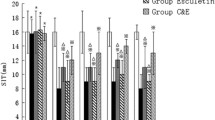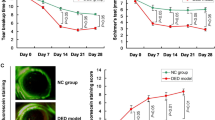Abstract
Objective
By observing the effects of electroacupuncture (EA) on the apoptosis of conjunctival cells of rabbits with dry eye syndrome (DES) and the expressions of apoptosis-related proteins Caspase-3, Fas and Bcl-2, to discuss the mechanism of EA in the treatment of DES from the perspective of cell apoptosis.
Methods
Male New Zealand rabbits were randomly divided into a normal group (NG), a model group (MG), an EA group (EAG) and a sham EA group (SEAG). DES rabbit model was developed by eye drop of 0.1% benzalkonium chloride. The rabbit tear secretion and tear film break-up time (BUT) were measured; terminal deoxynucleotidyl transferase-mediated dUTP nick end labeling (TUNEL) assay was used to detect the apoptosis of conjunctival cells; the expressions of Caspase-3, Fas and Bcl-2 proteins in conjunctival cells were detected by immunohistochemistry.
Results
Compared with the NG, the rabbit tear secretion decreased and the BUT was shortened in the MG (both P<0.01); compared with the MG and the SEAG, the rabbit tear secretion increased and the BUT was prolonged in the EAG (all P<0.05). Compared with the NG, the apoptosis of rabbit conjunctival cells increased (P<0.01), the expressions of Caspase-3 and Fas proteins increased (both P<0.05), and the expression of Bcl-2 protein decreased (P<0.01) in the MG; compared with the MG and the SEAG, the apoptosis of rabbit conjunctival cells decreased (both P<0.01), the expressions of Caspase-3 and Fas proteins decreased (all P<0.05), and the expression of Bcl-2 protein increased (both P<0.01) in the EAG.
Conclusion
EA can inhibit the apoptosis of rabbit conjunctival cells, down-regulate the expressions of apoptosis-related proteins Caspase-3 and Fas, and up-regulate the expression of Bcl-2 protein, which may be one of the mechanisms of EA in treatment of DES.
摘要
目的
通过观察电针对干眼症兔结膜细胞凋亡及相关蛋白Caspase-3, Fas和Bcl-2表达的影响, 从细胞凋亡角度探讨电针治疗干眼症的作用机制.
方法
雄性新西兰兔随机分为正常组,模型组,电针组和假电针组. 采用0.1%苯扎氯铵滴眼制作兔干眼症模型. 检测各组兔泪液分泌量,泪膜破裂时间; 采用末端脱氧核苷酸转移酶介导的dUTP 缺口末端标记测定(TUNEL)法检测结膜细胞凋亡情况; 应用免疫组化法检测结膜细胞Caspase-3, Fas和 Bcl-2蛋白表达.
结果
与正常组比较, 模型组兔泪液分泌量降低, 泪膜破裂时间缩短(均P<0.01); 与模型组, 假电针组比较, 电针组兔泪液分泌量增多, 泪膜破裂时间延长(均P<0.05).与正常组比较, 模型组兔结膜细胞凋亡增加(P<0.01), Caspase-3和Fas蛋白表达增加(均P<0.05), Bcl-2蛋白表达降低(P<0.01); 与模型组,假电针组比较, 电针组兔结膜细胞凋亡减少(均P<0.01), Caspase-3和Fas蛋白表达减少(均P<0.05), Bcl-2蛋白表达增加(均P<0.01).
结论
电针能抑制干眼症兔结膜细胞凋亡, 下调凋亡相关蛋白Caspase-3和Fas表达, 上调Bcl-2蛋白表达, 该作用可能是电针治疗干眼症的作用机制之一.
Similar content being viewed by others
References
Craig JP, Nelson JD, Azar DT, Belmonte C, Bron AJ, Chauhan SK, de Paiva CS, Gomes JAP, Hammitt KM, Jones L, Nichols JJ, Nichols KK, Novack GD, Stapleton FJ, Willcox MDP, Wolffsohn JS, Sullivan DA. TFOS DEWS II report executive summary. Ocul Surf, 2017, 15(4): 802–812.
Malik K, Matejtschuk P, Thelwell C, Burns CJ. Differential scanning fluorimetry: rapid screening of formulations that promote the stability of reference preparations. J Pharm Biomed Anal, 2013, 77: 163–166.
Than J, Balal S, Wawrzynski J, Nesaratnam N, Saleh GM, Moore J, Patel A, Shah S, Sharma B, Kumar B, Smith J, Sharma A. Fingerprick autologous blood: a novel treatment for dry eye syndrome. Eye, 2017, 31(12): 1655–1663.
Galor A, Batawi H, Felix ER, Margolis TP, Sarantopoulos KD, Martin ER, Levitt RC. Incomplete response to artificial tears is associated with features of neuropathic ocular pain. Br J Ophthalmol, 2016, 100(6): 745–749.
Kim BH, Kim MH, Kang SH, Nam HJ. Optimizing acupuncture treatment for dry eye syndrome: a systematic review. BMC Complement Altern Med, 2018, 18(1): 145.
Yang L, Yang Z, Yu H, Song H. Acupuncture therapy is more effective than artificial tears for dry eye syndrome: evidence based on a meta-analysis. Evid Based Complement Alternat Med, 2015, 2015: 143858.
Brinton M, Chung JL, Kossler A, Kook KH, Loudin J, Franke M, Palanker D. Electronic enhancement of tear secretion. J Neural Eng, 2016, 13(1): 016006.
Hang W, Li W, Zhang C, Zhu C, Yi X, Zhou Y, Lü Y. Effects of vitamin Aon expressions of apoptosis genes Bax and Bcl-2 in epithelial cells of corneal tissues induced by benzalkonium chloride in mice with dry eye. Med Sci Monit, 2019, 25: 4583–4589.
Park JH, Moon SH, Kang DH, Um HJ, Kang SS, Kim JY, Tchah H. Diquafosol sodium inhibits apoptosis and inflammation of corneal epithelial cells via activation of Erk1/2 and RSK: in vitro and in vivo dry eye model. Invest Ophthalmol Vis Sci, 2018, 59(12): 5108–5115.
Chen W, Zhang X, Liu M, Zhang J, Ye Y, Lin Y, Luyckx J, Qu J. Trehalose protects against ocular surface disorders in experimental murine dry eye through suppression of apoptosis. Exp Eye Res, 2009, 89(3): 311–318.
Gao J, Schwalb TA, Addeo JV, Ghosn CR, Stern ME. The role of apoptosis in the pathogenesis of canine keratoconjunctivitis sicca: the effect of topical cyclosporin atherapy. Cornea, 1998, 17(6): 654–663.
Li C, Song Y, Luan S, Wan P, Li N, Tang J, Han Y, Xiong C, Wang Z. Research on the stability of a rabbit dry eye model induced by topical application of the preservative benzalkonium chloride. PloS one, 2012, 7(3): e33688.
Xiong C, Chen D, Liu J, Liu B, Li N, Zhou Y, Liang X, Ma P, Ye C, Ge J, Wang Z. A rabbit dry eye model induced by topical medication of a preservative benzalkonium chloride. Invest Ophthalmol Vis Sci, 2008, 49(5): 1850–1856.
Wang CL, Cheng ZL, Li GL. Study on standardization of methods commonly used experimental animal acupoint location. Tianjin Zhongyiyao, 2016, 33(2): 100–103.
Li ZR. Experimental Acupuncture Science. Beijing: China Press of Traditional Chinese Medicine, 2007: 327–329.
Honkanen RA, Huang L, Xie G, Rigas B. Phosphosulindac is efficacious in an improved concanavalin A-based rabbit model of chronic dry eye disease. Transl Res, 2018, 198: 58–72.
Xue Y, Zhao YD, Yuan YJ, Wang XF. Research progress in nearly five years of acupuncture in the treatment of dry eyes. Yatai Chuantong Yiyao, 2017, 13(3): 59–61.
Guo MH, Cui EC, Li XY, Zong L. Observations on the clinical therapeutic effect of electroacupuncture on xerophthalmia. Shanghai Zhenjiu Zazhi, 2012, 31(4): 245–247.
Baudouin C. The pathology of dry eye. Surv Ophthalmol, 2001, 45(2): S211–S220.
Fernandez KB, Epstein SP, Raynor GS, Sheyman AT, Massingale ML, Dentone PG, Landegger LD, Asbell PA. Modulation of HLA-DR in dry eye patients following 30 days of treatment with a lubricant eyedrop solution. Clin Ophthalmology, 2015, 9: 1137–1145.
Yeh S, Song XJ, Farley W, Li DQ, Stern ME, Pflugfelder SC. Apoptosis of ocular surface cells in experimentally induced dry eye. Inves Ophthalmol Vis Sci, 2003, 44(1): 124–129.
Hagar H, Husain S, Fadda LM, Attia NM, Attia MMA, Ali HM. Inhibition of NF-κB and the oxidative stress-dependent caspase-3 apoptotic pathway by betaine supplementation attenuates hepatic injury mediated by cisplatin in rats. Pharmacol Rep, 2019, 71(6): 1025–1033.
Liu J, Yao Y, Ding H, Chen R. Oxymatrine triggers apoptosis by regulating Bcl-2 family proteins and activating caspase-3/caspase-9 pathway in human leukemia HL-60 cells. Tumor Biol, 2014, 35(6): 5409–5415.
Wang CQ, Li D, Liu HP, Li L. Effects of Yangyin Runmu pills on the expressions of caspase-3 and caspase-6 in conjunctival epithelial cells in a rat model of dry eye. Hunan Zhongyiyao Daxue Xuebao, 2019, 39(7): 848–850.
Sun JH, Wang JX. Inhibition of cyclosporine on apoptosis of conjunctival epithelium in experimental murine xerophthalamia. Yanke Yanjiu, 2006, 24(5): 506–509.
Xie J, Li B, Yao B, Zhang P, Wang L, Lu H, Song X. Transforming growth factor-β1-regulated Fas/FasL pathway activation suppresses nucleus pulposus cell apoptosis in an inflammatory environment. Biosci Rep, 2019: BSR20191726.
Yao XL, Peng QH, Chen QL, Tang YH, Zhong Q. Effects of total flavonoid of chrysanthemum on Fas and FasL expression in lacrimal gland cells of male castrated rabbits with dry eye. Guoji Yanke Zazhi, 2014, 14(10): 1749–1754.
Birkinshaw RW, Czabotar PE. The BCL-2 family of proteins and mitochondrial outer membrane permeabilisation. Semin Cell Dev Biol, 2017, 72: 152–162.
Cong Y, Wang WM. Relationship between Fas, FasL, Bax and Bcl-2 expressions in dry eye corneal epithelial cells induced by vitamin A deficiency and apoptosis. Zhongguo Shiyan Zhenduanxue, 2017, 21(10): 1820–1823.
Ouyang Y, Peng J, Peng QH, Tan HY, Li WJ, Wu QL. Effect of buddleia granule on Bax, Bcl-2, Fas, and FasL in lacrimal gland cells of castrated male rabbits. Zhongguo Zhongxiyi Jiehe Zazhi, 2017, 37(7): 858–862.
Strong B, Farley W, Stern ME, Pflugfelder SC. Topical cyclosporine inhibits conjunctival epithelial apoptosis in experimental murine keratoconjunctivitis sicca. Cornea, 2005, 24(1): 80–85.
Acknowledgments
This work was sponsored by the Youth Fund of National Natural Science Foundation of China (国家自然科学基金青年基金项目, No. 81904302); Scientific Research Project of Shanghai Municipal Health Commission (上海市卫生健康委员会项目, No. 2017BR047, No. 201840174, No. 201940130); Shanghai Sailing Program (上海市青年科技英才扬帆计划项目, No. 19YF1445000).
Author information
Authors and Affiliations
Corresponding authors
Additional information
Conflict of Interest
The authors declare that there is no potential conflict of interest in this article.
Statement of Human and Animal Rights
The treatment of animals conformed to the ethical criteria.
Rights and permissions
About this article
Cite this article
Yang, Yt., Wei, Bj., Zhao, Y. et al. Effects of electroacupuncture on conjunctival cell apoptosis and the expressions of apoptosis-related proteins Caspase-3, Fas and Bcl-2 in rabbits with dry eye syndrome. J. Acupunct. Tuina. Sci. 18, 16–23 (2020). https://doi.org/10.1007/s11726-020-1152-5
Received:
Accepted:
Published:
Issue Date:
DOI: https://doi.org/10.1007/s11726-020-1152-5
Keywords
- Acupuncture Therapy
- Electroacupuncture
- Dry Eye Syndrome
- Apoptosis
- Caspase-3 Protein
- Fas Protein
- Bcl-2 Protein
- Rabbits




